Archived News Item
now browsing by category
LIHEAP/REACH Assistance Available

The Social Services LIHEAP program will be accepting applications December 1 through March 1 for utility costs. The program is also administering Residential Energy Affordability Challenge Program (REACH) benefits for heating and air unit repair/replacement, hot water tank replacement, and installation of Energy Star appliances, and to help with utility bills.
For information on the programs, please go to the LIHEAP Program and REACH Program pages under Services/Programs.
Swearing In and Tribal Council Meeting, November 10, 1:00 pm

Tribal Council members Chester L. Brooks, Annette Ann (Martin) Ketchum, and Nathan H. Young, Chief Tribal Judge Donald E. Mason, and Associate Tribal Judge Charles Edward Randall will be sworn into office on Saturday, November 10, 2012 at 1:00 pm at the Delaware Community Center in Bartlesville. Tribal members are encouraged to attend.
A Tribal Council meeting will immediately follow the swearing-in ceremony.
Tribal Election Results

Congratulations to Chester L. Brooks, Annette Ann (Martin) Ketchum, and Nathan H. Young on their election to four-year terms on the Tribal Council; Donald E. Mason for his election to Chief Judge of the Tribal Court; and Charles Edward Randall for his election to Associate Judge of the Tribal Court.
Thanks to all Delaware tribal members who voted in the election!
A certified copy of the results of the election is on file at the Tribal Offices at 170 NE Barbara, Bartlesville, OK.
FINAL RESULTS OF THE 2012 GENERAL ELECTION FOR TRIBAL COUNCIL AND TRIBAL COURT
| TRIBAL COUNCIL CANDIDATES | Kansas Polling Place | Oklahoma Polling Place | By Mail | Total |
| Chester L. Brooks | 4 | 56 | 186 | 246 |
| Marilyn S. (Pickett) Cole | 1 | 27 | 76 | 104 |
| Annette Ann (Martin) Ketchum | 7 | 53 | 181 | 241 |
| John Wesly Sumpter | 3 | 52 | 95 | 150 |
| Nathan H. Young | 5 | 60 | 138 | 203 |
| CHIEF JUSTICE CANDIDATE | ||||
| Donald E. Mason | 7 | 67 | 305 | 379 |
| ASSOCIATE TRIBAL JUDGE CANDIDATE | ||||
| Charles Edward Randall | 7 | 76 | 304 | 387 |
| PROPOSED 2013 TRUST BOARD BUDGET | ||||
| Yes | 6 | 77 | 313 | 396 |
| No | 1 | 10 | 9 | 20 |
Delaware Tribe Veterans Recognition, November 9, 2012

DELAWARE TRIBE TO HONOR VETERANS ON NOVEMBER 9 IN BARTLESVILLE
The Delaware Tribe of Indians will honor tribal veterans at a special recognition ceremony on Friday November 9 at 10:00 am at the Tribal Community Center, 5100 E. Tuxedo Blvd in Bartlesville. All Delaware Tribal members who are veterans of the U.S. Armed Forces are invited to attend and receive recognition for their service. The keynote address will be delivered by John Henry Mashunkashey, a Marine Corps veteran from the Osage Nation. The ceremony is hosted by the Delaware Veterans Committee and Delaware War Mothers. The ceremony will be followed by a luncheon with tribal leaders and elders. For more information contact the Delaware Tribal Center at 918-337-6590.
Meet-and-Greet in Sacramento, CA, Oct 24, 2012

Attention: Delaware Tribal members living in the Sacramento, CA area
You are invited to a meet-and-greet reception on Wednesday Oct. 24, 2012 from 6 to 8 p.m. in Room 303 of the Sacramento Convention Center 1400 J Street, Sacramento, CA. Vice Chief Chet Brooks, Tribal Council Secretary Verna Crawford, Council member Nathan Young, Trust Board member Joe Brooks, Tribal Manager Curtis Zunigha, and Enrollment Director Leslie Fall-Leaf will be attending the NCAI (National Congress of American Indians) conference scheduled that week and look forward to the opportunity to meet with you.
Documentary Film Pre-Production, “Heart of the Drum”

HEART OF THE DRUM, a feature length documentary film, was approved by the Tribal Council, by a unanimous vote to start the pre-production phase of the project. A Tribal Resolution is in effect to begin co-production with Angel City Film Works.
(Please note: Heart of the Drum is a working title for pre-production and fund raising; the final name is yet to be determined by agreement between the tribe and the film makers.)
Heart of the Drum portrays the constant rhythm of the cultural center of the tribe as a source of identity and renewal. We shall draw forward many untold stories of the Delawares’ participation and contribution to America’s history through the pre-Civil War and Civil War era into the present day.
 Edie Robinette-Petrachi and Jack Robinette
Edie Robinette-Petrachi and Jack RobinetteThis is a combined modern day story that emphasizes the tribal perspective on growth while honoring the richness of heritage. Through humor, stories, and music the viewing audience will be engaged and surprised to learn how the Lenape Language and culture is a part of their daily lives today.
There are two key components to the collaborative agreement between Angel City Film Works and the Delaware Tribe of Indians. The first is that the copyright of both the intellectual property and the film itself shall remain with the tribe. The Tribe will function in the role of Executive Producer. The film makers have already secured PBS broadcast interest for the film in multiple locations.
Second, there is a plan to collaborate creatively on the vision development of the project. Anita Mathis, Tribal Archivist and Librarian, is the Project Director for the tribe under the guidance of Chief Paula Pechonick and Tribal Manager Curtis Zunigha. A committee will be created to focus the creative collaboration as well as review written content in funding proposals and for the film itself.
Film production will take place over the next twelve months. Included in the content will be interviews with the tribe, audio recordings, archival video interviews, photographs, maps, and narrated letters. Original music and graphic design will be created by tribal members. This style of documentary storytelling will allow individuals to personalize the film and connect back to Kansas through family and tribal collections. Some filming will occur of the cultural events at Delaware Days, but the in-person interviews are planned for later in the fall.
On location filming will occur in Ste Genevieve; Delaware Town near Springfield, MO; Fort Leavenworth; Kaw Point; and all points on the reserve between the Kansas and Missouri Rivers. The filming is being planned to capture the beauty of all four seasons.
Several points of story and interest, such as Grinter’s Place, White Church, and Delaware Town, will include interviews with current-day curators and scholars who have affiliations with the tribe.
If you are interested in participating in the film project interviews, an announcement will be made for sign-ups in October, after Delaware Days.
You can also participate by gathering with family members to share stories and discuss your own family trees. Digital copies of photos or letters can be made to use in the film and to be archived in the tribal libraries.
Stay tuned for updates on the tribal web site (www.delawaretribe.org), the electronic bulletin board in the Delaware Community Center, and at www.delawaresdoc.com. For further information, contact Anita Mathis, Tribal Archivist and Tribal Project Director (amathis@delawaretribe.org); Edie Robinette-Petrachi, Film Director (edie@angelcityfilmworks.com), or Jack Robinette, Producer (jack@angelcityfilmworks.com).
 |
|
 |
 |
 |
 |
Council, Trust Board, and DEA Extend Sincere Thanks to Wayne Stull

Wayne resigned from these three recently in order to have time to pursue other interests He dedicated much of his time over more than ten years of service to the Delaware Tribe of Indians. During that period he served on Tribal Council (two terms as Assistant Chief), Trust Board (multiple terms, most recently as Trust Board Chair), and Delaware Enterprise Authority (DEA) for over five years. Members of all three groups are sorry to see Wayne resigned, will miss his efforts for our Delaware Tribe, and wish him, and his family, all the best possible in all their future endeavors. Sincere thanks for your many years of service to Delaware Tribe of Indians, Wayne!
—Chet Brooks, on behalf of the Tribal Council, Trust Board, and the rest of tribal government

Tribal Members and Staff to Speak at 2012 Ethnohistory Conference

Tribal Historic Preservation Director Brice Obermeyer, Archaeologist Greg Brown, and tribal member and historian Nicky Michael will present papers at the 2012 Ethnohistory Conference, November 7-10, 2012, at Springfield, Missouri.
The speakers are part of a panel titled THE DELAWARE AND THE OZARK FRONTIER IN THE EARLY 19TH CENTURY, chaired by tribal historic preservation officer Brice Obermeyer. Part 1 of the panel, which includes talks by Dr. Obermeyer and Dr. Michael, will be held on Thursday, November 8 from 9:00am to 10:45am; Part 2, which includes talks by Missouri State archaeologists Marcie Venter and Neal Lopinot as well as tribal archaeologist Greg Brown, will be held on Friday, November 9 from 10:00am to 11:45am.
An afternoon tour of the Delaware Town area, site of the recent archaeological work sponsored by the Tribe, will be held Friday, November 9 from 2:00pm to 5:0pm.
Tribal members are encouraged to attend. The conference has kindly offered complimentary registration for tribal members. If you are interested, please contact Brice Obermeyer at bobermeyer@delawaretribe.org or by phone at 918-335-7026. If there is sufficient interest, the Tribe may be able to offer transportation to and from the event.
Panel Details
Abstract: As one of many Eastern Woodland tribes removed west of the Mississippi River prior to the Indian Removal Act, the Delaware were confronted with several new challenges and opportunities following their relocation to the Ozark region of what is today southern Missouri. Panelists will explore this unique but brief period of Delaware history through recent archaeological, historic and ethnohistoric research.
Note: The panel will be followed by a guided tour of the National Register-eligible Delaware period sites in the James River Valley south of Springfield.
Participants
Trail Beginnings and the Delaware in Missouri
An oft-used quote from the American colonial era describes the Shawnees as the “greatest travelers,” and it is not a description without merit. Yet even a quick glance at the journeys and migrations of Delaware individuals and communities west of the Mississippi River in the mid-nineteenth century indicates that the Delawares of that era may challenge for that title. In the midst of relocations and removals that are more established in the historical narrative, the stories of widespread Delaware movement casts light on a more expansive history. Delaware traders on the Santa Fe Trail and Delaware scouts on military expeditions with the Pathfinder, John C. Fremont serve as only two examples of a larger picture. In this paper I examine the notion that before the border towns of western Missouri became a jumping off point for Americans heading west, the region was already a starting point for the many trails Delaware Indians traveled west of the Mississippi River.
One Step in a Long Journey: Integrating Delaware Town Archaeology into a History of the Lenape People
The journey of the Delawares near Delaware Town in the early 1800s was a short episode in a much longer story spanning many thousands of years. This paper describes an ongoing project aimed at enabling modern Delaware descendents to understand and disseminate their own history. Efforts are described to place the archaeological evidence for Delaware Town into a context that also incorporates language revitalization, stories and knowledge passed from tribal elders, historical research, NAGPRA-funded repatriations, and electronic digitization and analysis of allotment maps and other cartographic resources.
“I [Have] You All By the Hand”: Practical Politics of Identity at Delaware Town 23CN1
Long recognized as the “Grandfathers” of other Eastern Algonquian groups, the Delawares held a special status among other indigenous groups and colonial governments in the East. However, upon crossing the Mississippi River, the main body of the Delawares found themselves under new administration that did not recognize this status and preferred the business of Osage rivals. This paper, as part of my dissertation, examines both documentary and archaeological resources to illustrate key ways that tribal leaders negotiated and exerted their collective identities as Delawares to affect political, economic, and social outcomes of their choosing.
“What’s for Supper?” Plant and Animal Remains from the Delaware Town Site
The assortment of plant and animal remains in 12 flotation samples from excavated features at the Delaware Town site (23CN1) are described. In particular, the fill of Feature 2, a sub-floor pit associated with a residential structure (Feature 3), perhaps even the home of Chief Anderson, contained a considerable amount of charred plant and animal remains, as well as a great array of artifacts diagnostic of a Delaware occupation. The contents of the samples indicate a diverse subsistence strategy that included crop cultivation and animal husbandry, as well as gathering, hunting, and fishing. This subsistence strategy is consistent with a traditional mixed economy dominated by horticulture and hunting, although perhaps some crops and domesticated animals may have been purchased from traders and other Euro-Americans living nearby in southwest Missouri. The analysis also reveals a conspicuous absence of Old World domesticates such as peach, watermelon, cantaloupe, etc.
“A Nation of People”
This paper will explore mid-nineteenth century Kansas and Texas Delawares’ expression of cultural/ethnic unity. Within this expression of ethnic identity the Delawares included and shared with other tribal nations. This shared sense of ethnic identity played a role in the Kansas Delawares final 1866-67 Removal to the Cherokee Nation. Kansas Delawares did not conceive of the Texas Delawares as a separate nation or separate identity. To the contrary they saw themselves as originating from the same ethnic Delaware whole. Both groups even shared some of their same leaders and a number of members travelled back and forth regularly.
From the time of Delaware leader William Anderson, Kik Tha We Nund, one can see the top priorities for their removal to Kansas in 1831, was to induce the federal government to provide the Delaware Nation a good reservation in Kansas where he thought the Delawares could draw in splinter groups from the rest of the country and Mexico. In addition, Kik Tha We Nund sought to revitalize Delawares’ traditions. Thirty-five years later, to physically reunite with their brothers and sisters who were living in Texas, the Delawares sought to include the Texas Delawares in their November 1866 Agreement with the Cherokee Nation for their final reservation in Indian Territory.
Upon removal to Indian Territory in 1867, the Kansas Delawares were unable to secure the reservation that they thought they had gained. In part, the federal government’s goal of destroying Native American cultures included the separation of the Delawares.
“When we lived back east”: Contemporary views on Delaware Removal and Settlement on the American Frontier
The Delaware Tribe is the descendant political organization of the Munsee and Unami speakers that coalesced with other eastern Algonquin and Woodland peoples to form the main body of Delaware by the late 18th century. An overview of this coalescence, dispersal and eventual removal to Southern Missouri and finally eastern Oklahoma is provided to help introduce the session and the Delaware experience. Particular emphasis is placed on viewing this removal experience from the perspective of contemporary tribal members.
Delaware along the James: A Decade of Ethnohistorical Archaeology in Southwest Missouri
As a result of the Treaty of St. Mary’s (1818), the main body of the Delaware migrated from the White River valley of Indiana to the James River valley of southwest Missouri. Led by Captain William Anderson, they made the region their home, settling along the banks and terraces of the river and its tributaries from about 1821 to 1830. Information gleaned from ethnohistoric and historic sources has inspired, guided, and at times complicated the archaeological study of Delaware Indian occupation in the region. In this paper, I review the recent history and challenges of problem-oriented Delaware research in southwest Missouri, synthesize what complementary documentary and archaeological data have told us about the group’s Removal period occupation, and suggest areas for future investigation.
Delaware War Mothers Reorganizing

It is with great pleasure to announce the reorganization of the Delaware War Mothers. This great organization consists of Grandmothers, Mothers, Daughters, Granddaughters, Sisters and Aunts who represent all Veterans. Our mission is to represent and honor our military relatives as well as visiting veterans who are shut-ins at their own home or a resident of a nursing home. Some past activities with veterans were helping them open their Christmas gifts at the Claremore Veterans Hospital, visiting with them so they see new faces, and sent phone cards overseas to active duty service men and women. Other past activities were wearing the club robes during grand entry at various powwows and participating in local parades. Do you have ideas to help honor these fine people who have fought for our country and freedom? Then please consider joining the Delaware War Mothers. If you are a female Native American and would be interested in joining please attend one of the meetings that are scheduled for the second Wednesday of every month at 1:00 pm in the dining hall at the Delaware Community Center. If you would like more information please contact Bess Marler at 918-440-1955, Evelyn Kay Anderson at 918-397-5116 or email the club at delawarewarmothers@yahoo.com. The club would like to be active by January 1, 2013 so we can kick off the year fresh and be ready to assist our veterans.
Delaware Days 2012

Friday/Saturday, Sept 28–29
Delaware Days 2012 will be held at the Fall-Leaf Dance Grounds northeast of Copan, Oklahoma, on September 28 and 29. It will be the 20th Annual Delaware Days sponsored by the Delaware Culture Preservation Committee. The first Delaware Day was held in September 1993 and was attended by more than 250 people.
The events will begin on Friday evening with a potluck dinner at 6:30 and then a Stomp Dance with Social Dance songs. In the late afternoon on Saturday there will be presentations to two tribal members—the elder of the year, and the honored veteran. On Saturday at 5:30 there will be a potluck supper at which the Culture Committee will supply the meat. Everyone else should bring some food to share. Then there will be a Stomp Dance with Social Dance songs, and we will dance as long as everyone wants. Please join us!!
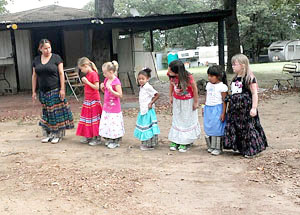 |
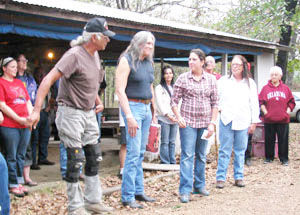 |
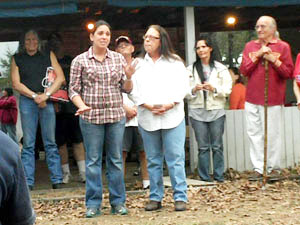 |
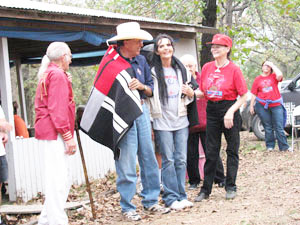 |
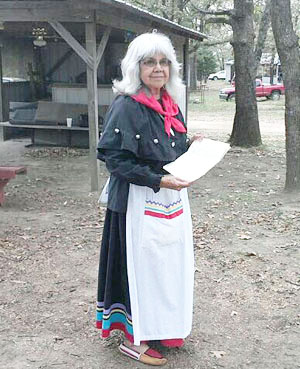 |
 D5 Creation
D5 Creation